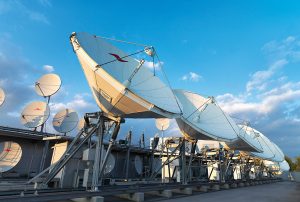 Teleports have evolved at a rapid rate from simple infrastructure providers to outsourced providers of complex managed services. In media, they assemble programme streams from multiple inputs, originate channels and distribute through multiple paths including satellite, fibre and internet.
Teleports have evolved at a rapid rate from simple infrastructure providers to outsourced providers of complex managed services. In media, they assemble programme streams from multiple inputs, originate channels and distribute through multiple paths including satellite, fibre and internet.
There is still the need to service the allotted spectrum, which remains in C-band, Ku-band and most recently Ka-band. As the frequency goes up, the profile accuracy of a teleport’s antenna becomes more stringent. It is most unlikely that an antenna profiled for C-band can work for Ku- or Ka-band, whereas an antenna profiled for Ka-band has a good margin of accuracy for Ku-band and C-band operation.
Roger Boddy, CEO, Global Teleports, says: “Over the past decade, there has been a growth in smaller hub antennas for operation in Ka-band, each determined by the question of whether or not they should be multi-band to support Ku- and C-band, therefore influencing the components of the teleport.”
“It is essential that a teleport has its own staff to maintain the day-to-day operational capability of the teleport. Some functionality can be outsourced where work can be scheduled, for example cleaning of antennas and structural maintenance. Having said all that, both the availability and the ability to switch to redundant equipment in the event of a failure is an important necessity in meeting contractual service level agreements.”
Tomas Lovsin, CTO at STN teleports, thinks the first change was the move of old analogue infrastructure, specifically RGB video and analogue audio, to serial digital interface (SDI), and more recently the transition from SDI-based infrastructure to IP-based solutions.
“IP-based infrastructure offers more flexibility and much easier maintenance as well as operations costs compared to SDI. Ethernet switches have proven to be considerably more user friendly than the use of SDI routers,” says Lovsin.
Robert Bell, Executive Director at WTA, says media-centric teleport operators are guiding broadcasters into OTT services and providing advanced automation that turns OTT streams into revenue.
“On the data side, teleport operators design, install and manage networks in every satellite vertical market and far beyond. The UK’s largest teleport operator also delivers video programmes to the London Underground,” adds Bell.
All our experts agree it is necessary to have a highly specialised in-house team to run the teleport and protect it from downtime 24×7.
Lovsin explains: “The advantage of having own in-house tech-support and engineering is of course the response time in case of unforeseen problems or issues that a teleport can and does encounter. While it is of paramount importance for a teleport to have service agreements signed with all the major hardware and/or software providers, it still takes time for a provider to act. If a teleport has skilled engineers to operate, maintain and service the equipment on its own, not only does this help with the servicing, but also does significantly shorten the response time to mitigate the possible errors and rectify the problems.”
When it comes to things like latency and jitter, any well designed teleport infrastructure should be designed to minimise these and many other things. Over-subscription is obviously an issue, but there are many more.
David Andres, Business Development Manager at Santander Teleport, explains some of the other causes of latency. “There are other factors, such as how the teleport connects to the outside world, whether it is through a high-tier ISP or a lower standard connection; wrong choice of carrier parameters on a VSAT network; the type of equipment used at the remote end – lower performance modems are often an issue, since these cannot cope with high packets per second ratios and they are not able process enough TCP sessions. To provide a service with good standards, there is a minimum quality required and a minimum investment to make. Operators and service providers that only consider cost in their decisions suffer from unhappy customers.”
Teleports generally operate mission-critical networks for business and trunk networks for consumer communications service providers that in turn sell retail services.
In mobile and transportation markets, they often also manage the network nodes, whether they are cellular base stations, ships or oil platforms.
Bell says: “When a network is over-subscribed, quality problems multiply, including latency, jitter and slow overall speeds. Quality providers carefully manage demand and capacity, using technologies that provide their customers with flexibility on demand.“
“There is a never ending problem in the marketplace between performance and price. Customers who insist on buying the lowest price in return for promises of high performance can expect to get what they pay for. Quality operators strive to optimise networks to provide high performance at the lowest attainable cost, and they tend to keep their customers rather than seeing them come and go.”
Boddy adds: “Today’s market demands best quality at least cost. Offering CIR sacrifices contention at the expense of dedicated capacity. Conversely, a least cost-effective service can be offered with contention at the expense of CIR. Whereas traditional satellite service tariffs were based on CIR, the new breed of high-throughput satellites (HTS) offer charging on the basis of how much is used rather than how fast it was delivered. This presents an opportunity to apply a mathematical algorithm that allows a sharing of throughput without overselling the capacity.”
Best practice is to make sure end users know what they are buying into. There are many virtual teleports (VNO) today acting to resell from a real teleport. Each VNO is offered a portion of capacity to resell, often with scant understanding of the limitations. This has led to many adopting a ‘white goods sales mentality’, with sales promoted regardless of network capacity. Many feel this is the prime cause of over-subscription, leading to congestion.
Certifications
Bell explains that WTA’s Teleport Certification standards were developed by a committee of teleport operators to cover nine key areas of facility design and six key areas of operating procedure, for a total of 170 individual data points.
The Teleport Certification Programme provides four levels of certification, from Tier 4 to Tier 1.
Each level reflects a set of clear and objective standards for facilities, technology and operating procedures. Certification at one of these levels indicates, at a minimum, that the teleport complies with the standards of that level.
Andres says: “Certification standards serve as a guideline to differentiate quality standards among companies offering products or services. Companies may apply for industry-wide quality certifications such as ISO 9001-9908 and/or more industry-specific certifications such as the WTA teleport certification. Companies applying will provide information answering to questions relating to their facilities, and secondly management processes that describe how well the company is managed to serve their clients.”
Any certification – ISO, WTA and the like – has value. The question is how these certifications benefit a teleport. Lovsin thinks both ISO and WTA standards have been made first and foremost to benefit companies. ISO standards are more general, whereas WTA certification has been specifically adopted for teleports. He feels WTA certification gives the end customer a certain guarantee that the service provided meets expectations.
Value Proposition
So how do operations, staffing, processes and capital expenditure change in a fibre, wireless and HTS world? Moreover, how does the teleport maintain its value proposition in competition with terrestrial carriers and data centre operators?
Boddy says teleports have indeed traditionally been used for fixed satellite operations, but increasingly they are serving mobile communications for ships at sea, tracking of land vehicles and, most recently, aeronautical applications.
“It should not be overlooked that teleports are gateways to national infrastructures often extending a last mile connectivity to places that fibre and fixed line radio links cannot reach. As such, teleports must interconnect with fixed line radio and fibre back bone infrastructures, but the operations staff must also be appropriately skilled to manage these systems.
“This goes back to the first question addressing the degree of outsourcing to define the OPEX and CAPEX budgets of the teleport. Proper planning preventing painfully poor performance (P6) will apply to the component structure and infrastructure of the teleport to accommodate these interfaces. Finally, the optimum teleport infrastructure is IP-based. As such it will naturally accommodate the triple play service requirements of various customer applications. Teleports also offer a unique point to multipoint capability that is unmatched by terrestrial carriers and data centre operators,” he explains.
Andres says it is clear that teleport operators are very competitive in providing services where terrestrial infrastructure is expensive and difficult or not possible to deploy, or where quick deployment of connectivity is required.
“Many teleports like Santander Teleport in Spain are built to very high standards to serve critical services, since these become hubs that connect multiple satellite connections to the terrestrial world. Therefore, well managed teleports are able to provide connectivity services with very high SLAs. This is key to the most critical services.”
According to Bell, it has been many years since teleports were satellite-only facilities. As the meeting point between the digital highway and skyway, they play an essential role in connecting different, often incompatible, technologies and transmission paths.
“A full-service teleport today is a combination data centre, network operations centre, satellite uplink hub, fibre network and provider of distribution services over the internet, and its services include the design and operation of complex, hybrid, managed networks. As HTS becomes an increasingly important satellite architecture, they are serving as gateways and integrating by-the-megabit capacity into their service offerings for customers.
“Teleports compete on their comprehensive understanding of digital technologies and transmission technologies. It has been said that if you can get an IP-based data or video network to operate with high efficiency over satellite, you know more about transmission and information technology than just about anyone else. That will be the enduring competitive advantage for the industry,” concludes Bell.












Add Comment